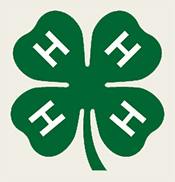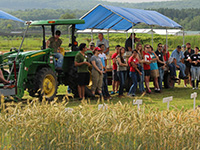Where Did the Idea Come From
Partnerships
The Importance of Ownership
Naming the Garden Project
Logic Model
Downloadable pdf of this webpage.

Where Did the Idea Come From
Developing a plan summary is a good way to ensure your gardening program starts off on the right track. Create your own Plan Summary with this Plan Summary Activity (pdf).
- At the science museum, did the staff agree that a garden would make a dynamic, hands-on exhibit, based on comments by visitors and support from volunteers—or did the director, an enthusiastic gardener herself, make a spontaneous decision that the staff should put in a garden?
- At the school, were most of the teachers eager to utilize a garden because of its opportunities for interdisciplinary education—or did one teacher decide, on a whim, that it would be nice to put in a planting that weekend?
- At the cooperative extension office, did the extension educators and their Master Gardener volunteers determine that a garden would make an excellent outdoor learning facility, based on community demand—or did the county coordinator ask the staff to put in a garden because it would be good public relations?
The long-term success and health of your program will depend a great deal on whether or not you’ve developed a broad base of interest for the project. Imposing a program on anyone, adult volunteers or youth participants, can squelch excitement and momentum. Take a step back–if need be–to generate support, ask for input, and cultivate ownership of the project among the people involved.

There are three approaches to implementing community projects.
Doing to: A top-down approach. For example: An agency feels that a gardening program is needed by the community, and goes ahead and implements it without community support. Essentially they “do the gardening project to” the community. Or, a group of adults think a gardening project would be good for students or community youth, so they go ahead and plan and build the garden. They do all this without youth support.
Doing for: Other well-meaning agencies may sense that there is a demonstrated need, so they do the gardening project for the community. But, without a broad base of involvement, these projects may fall by the wayside for lack of long-term support.
Doing with: The best approach is to collaborate in each phase of the project – to do it with the community. Community members engaged in each phase of the project are much more likely to feel committed over the long haul.
Partnerships
- Identify potential partnerships with this exercise focused on Establishing Partnerships (pdf).
- Use the Garden Circle of Influence (pdf) to help establish and articulate the benefits to those involved with the project.
- Having a well-planned elevator speech is a good idea for any project, establish your own with this Elevator Speech Activity (pdf).
Roles should be clearly defined before the spade ever meets the soil. Few garden projects function well without dedicated volunteers, staff, parents, teachers, or other educators working together with clearly defined roles. Ironing these out well in advance will save time, will ensure that the bases are covered, and will prevent tension that can come with wrongly made assumptions.
When the advisory/planning committee first gets together there are a few things to do in order to keep meetings focused:
- Distribute a tight agenda, and stick to it.
- Iron out the project objectives, so that everyone agrees on the goals.
- Clearly define everyone’s roles. If the gardening program will be large, form subcommittees to tackle portions of the project.
Do not be dissuaded just because your organization lacks the people to cover all aspects of the program. After all, is there any one group that can do it all? More importantly, would the program benefit from a “one-man band” anyway? If your program lacks diversity, partnerships will strengthen the program. In fact, partnerships will even enhance the agency that does have the skills at hand. Just be sure that it is clear what is expected of whom before the project begins, and that all parties have agreed to hold up their end of the bargain.
Adults:
- Who are the adults involved with the project: parents, teachers, club leaders, Master Gardeners?
- What are their roles: recruiting volunteers, serving on the planning committee, community outreach, fund raising, garden maintenance, etc?
Youth:
- Who are the young people involved
in the project: students at a school, 4-H club members, youth who frequent a community center? - What are their roles: in planning the garden, in generating support for the garden (enthusiasm, funds, materials), in building the garden, in caring for the garden?
Partnerships:
- What are some possible partnerships in your community: Elementary School – Master Gardeners – Local Nursery- 4-H Club – Garden Club – Nature Center?
- What roles will each partner play: planning the garden, providing expertise, supplying materials, building the garden, recruiting volunteers, raising funds, etc?
Administrative Support:
- Convincing administrators may be quite easy, or very difficult, depending on their philosophical approach to outdoor learning. Some administrators see this type of project as critical, and immediately recognize all the benefits. Others may view a growing project as unnecessary, as an “add-on,” or even as a liability issue. Whatever their perspective, it is critical to involve administrators early on, and to keep them informed of your progress. It is even more critical if they do not fully support the program initially. Be prepared, you may want to present a one-page summary of your plan. A thorough approach will be the first step to persuading a hesitant director of the program’s validity.

The Importance of Ownership
Learn more with this case study and exercise focused on the Importance of Ownership (pdf).
Every step of the way, think about ways to instill ownership. Passing plants and stakes down the line, inviting people to harvest parties, keeping the gardening program highly visible, and otherwise involving people at each step enhances the sense that the garden belongs to the participants.
- More people will appreciate the project and feel as excited about it as you do.
- More people will be committed to help caring for the garden, taking the burden off of one or a few people.
- More people with know about the garden and the effort that’s gone into the project, helping to reduce vandalism.
- The garden will likely last over time, even when planners have moved on to another project or are faced with life changes that take them away from the garden project.
Naming the Garden Project
Names spark zest, and even impart meaning. It would be a pity to go so far in a program only to wind up referring to it as the “Library Garden,” the “Youth Garden,” or the “School Garden.” “Habitat Discovery” or “Salsa” gardens feel decidedly different from “Ladybug Land.” By the same token, which would volunteers rather join: the “Garden Committee” or the “Green Team”? Holding a “garden-naming” contest can generate excitement, as well as community pride. Remind contestants of program goals, and encourage them to subtly weave the primary objectives of the garden into the title. Short, easy-to-pronounce names tend to be more memorable.
This contest offers yet another opportunity to develop a sense of ownership. Names can even change the flavor of the project. Michigan State’s 4-H Children’s Garden could have had a “Grain Garden,” but instead opted for a “Cereal Bowl.” It is much more creative, appealing, and descriptive, and paints a picture of how the garden might look.
Logic Model
The CGBL logic model (PDF download) is a simple work tool to assist you in planning, organizing and assessing your garden project goals, activities, partners and more. The words within each box are only meant to be a guide; feel free to create your own. This tool is priceless for planning effectively and will surely give you an edge when used for grant writing!











